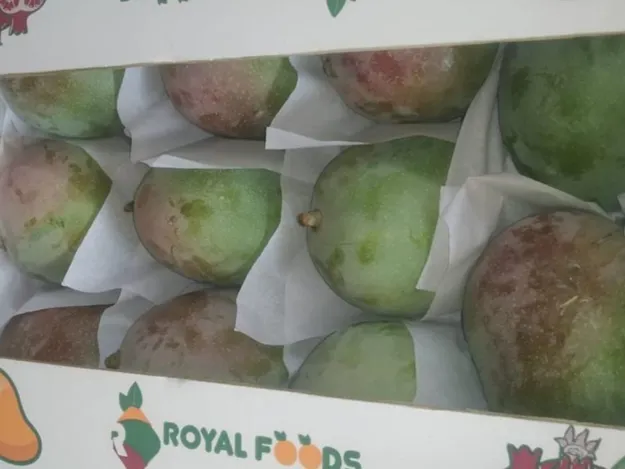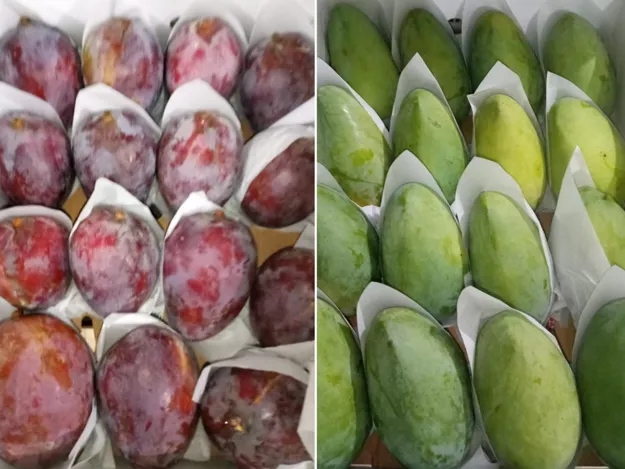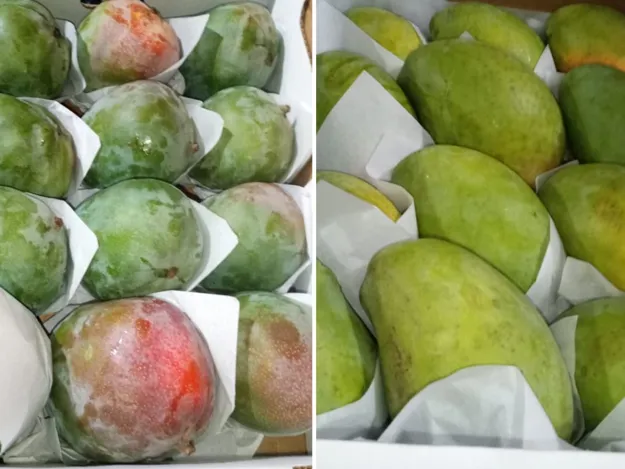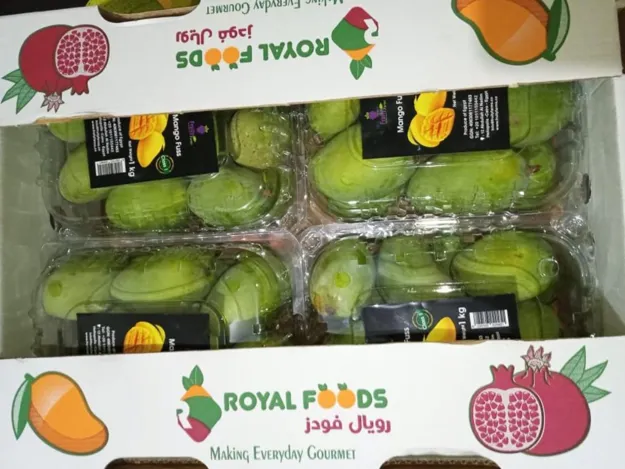In France, domestic raspberry consumption struggles to compete against imported varieties while producers focus on increasing in-store promotions. Italy looks forward to a good raspberry season, with regions such as Vinschgau, Piedmont, and Sicily delivering exceptional quality. Spain faces lower raspberry volumes, leading to higher prices for growers, while Serbia grapples with a lower harvest due to adverse weather conditions.
Ukrainian raspberry growers experience low prices, highlighting the need for improved infrastructure and cold chain management. The North American market is facing a lack of supply this season due to the low production in Mexico caused by hot weather.

Netherlands: Raspberry prices not overly high
Prices of Dutch raspberries are currently at a level of around 1.30 euros for 125 grams. "Not overly high," observes a Dutch fruit trader. "Raspberries are a fairly labor-intensive crop, and with the increased picking costs, growers will not be overly happy with this. Dutch supply is plentiful. At the same time, demand, including in German-speaking countries, is reasonably level." However, according to the fruit trader, increasing volumes of raspberries are coming from Poland, where investments are also being made in better varieties such as Lagorai.
Belgium: Recent heat holds back top raspberry productions
The Belgian supply of raspberries is still relatively limited at the moment. While in many countries, production has already started in full swing, in Belgium, the recent warm weather has meant that top productions are still away. "Because of the heat, the plants have gone into a kind of survival mode, which means that the volumes are not yet at an exceptional level. It's also resulting in relatively higher prices for the time of year, because they do have a lot of demand during the summer. In the coming weeks, the market is expected to ease somewhat."
Germany: Production increase in Lower Saxony
For raspberries, traders have been able to fall back on regional outdoor products for around three weeks; before that, there were already tunnel and greenhouse raspberries. "At the moment, sales seem to be falling somewhat, which is precisely due to the fact that the vacation season in several regions has already begun. However, prices are still mostly firm and stable with an average demand, a trader confirms. The domestic soft fruit would be in direct competition with imported goods from numerous countries. "Not only growing countries such as Portugal and Morocco are still represented on the market, but also overseas countries such as South Africa and Mexico. This is definitely noticeable in marketing. Meanwhile, the first goods from Poland and Serbia are hitting the market.
Due to new cultivation methods, raspberries in the important growing area of Lower Saxony can now be harvested from May until September. In 2022, 192 tons of raspberries were harvested outdoors in Lower Saxony. The current weather, warm temperatures, and sunshine suggest very good fruit quality on the farms. In recent years, the cultivation of raspberries has increasingly shifted from the open field to protected cultivation: "This allows us to offer the food trade consistent quantities and qualities, regardless of the weather," explained a growing consultant.
UK: Midlands earliest raspberry-producing region this year
The eagerly anticipated UK raspberry season began in mid-May, albeit around 10 days later than expected. "We are now in full production," said a representative from a grower's organization. "Traditionally, our Kent growers will be first, then we move up the country, but this season has seen an untypical spread with growers in the midlands having an earlier than usual season."
However, there is currently a higher supply of raspberries than the demand requires. It remains uncertain whether this surplus is due to an oversupply in the market or if the ongoing cost-of-living crisis is affecting consumer demand.
In recent years, there has been a modest increase in the total acreage dedicated to raspberry cultivation in the UK. This expansion, coupled with the introduction of new varieties and improved growing techniques, has contributed to increased production. As a result, retailers have adjusted their marketing strategies, opting for larger pack sizes and reduced prices per kilo instead of frequent 2-for-1 offers. While this benefits consumers, it does impact the returns received by growers.
As for the overall outlook for the season, it is still too early to determine its success. Typically, demand from Scottish consumers is robust, as they have a preference for locally grown berries. At present, the labor supply appears to be adequate. However, the main challenge lies in the diverse origin of the workforce, with language barriers sometimes hindering productivity. Additionally, fewer returning workers pose an additional obstacle to maintaining productivity in the fields.
France: Consumption of domestic raspberries still low
At the beginning of July, all raspberry production regions in France are now active. With average temperatures in May, it has not been an early year, as was the case in 2022. The last high-altitude regions started up last week, the campaign has also begun in the north and is in full swing in the Rhône-Alpes and south-west regions.
From this week onwards, raspberry volumes should intensify and further swell supermarket shelves in France. Unfortunately, in terms of marketing, French raspberries are still encountering difficulties due to the large number of imported raspberries on supermarket shelves, competing with French origin. The rate of consumption of French-origin raspberries is only 15%. In other words, 85% of raspberries consumed in France come from abroad. The biggest challenge in marketing French raspberries is to open lines in supermarkets and keep them there. Like strawberries, raspberries are a very weather-sensitive crop, with production peaks and troughs. At certain times, it can therefore be difficult to supply the lines, which does not encourage supermarkets to reduce imports in favor of domestic produce.
What is certain, however, is that the French are eating more and more raspberries, if we look at consumption over the last few years. To boost consumption, in-store promotions are planned in the weeks corresponding to production peaks.
Quality was quite good at the beginning of the campaign but unfortunately came up against a strong development of Drosophila Suzuki, a fly that causes damage and deteriorates quality. The impact of this fly varies from one production basin to another.
Italy: Portuguese raspberries extremely competitive on the Italian market
Raspberries are the second most cultivated soft fruit in the Vinschgau (surpassed in quantity only by strawberries); they are planted at an altitude between 900 and 1,700 meters above sea level. Approximately 30 tonnes of product are available from July, with very high quality is expected. An operator from the north of Italy explains that a lot of production comes from the high mountains. His raspberry plants are located up to 1400 meters above sea level. The harvest, in his case, started about ten days ago and will continue, in a gradual way, until the first frost at the end of October. The quality is good as all the produce is protected by tunnels. The raspberries are packed in 30x40 cm boxes, 8 baskets with a total weight of 1 kg per box. The customers are mostly wholesale markets in northern and central Italy. The price in recent days has been around 8-10 €/kg.
In Piedmont, the raspberry harvest started in May. "The volumes being harvested at the moment are very limited. Our plants are re-flowering, so we will have about 15 days between the first harvest cycle of May June and the second," explains an operator. "In May and June, sales got off to a good start, with quotations of about 9-10 euro/kg for the product destined for retailers and even higher prices in the wholesale markets. At the end of June, our raspberry sales were around 6 €/kg, and then rose again this week (the 27th of 2023) to 8 €/kg." In the Italian wholesale markets in mid-June, raspberries of Portuguese origin were also sold at a prevailing price of 18.50 €/colli against 20 €/colli for the Italian product. "The Portuguese raspberry was extremely competitive in terms of prices, and the same was seen on blueberries," he continues. "Products from Poland, the Netherlands, and Belgium will also start arriving soon. These are countries that have been investing in soft fruit for years and are already well established in our markets."
This year's Sicilian raspberry campaign has lasted over a month and will end at the end of July. There has been great satisfaction for the producers right from the start. "We started harvesting at full strength at the beginning of January and have continued practically without interruption," says a grower. "Our top variety is called 'Shani' and is highly suitable for our hilly areas. We recorded a few brief episodes of mold in May due to the wet and rainy weather. We intervened with antagonistic fungi. The sales season was quite satisfactory. In January, we had production prices of 12-13 €/kg. These prices held up until April when they dropped to 7-8 €/kg. Currently, quotations are around 6-7 €/kg."
Spain: Low volumes offset by high prices for growers
The Spanish raspberry campaign has practically ended, with less volumes sold than in the previous campaign. Until the end of April, the estimated average decrease in volume was 21%, according to data provided by marketers in the sector. As a result of the lower supply, prices received by the grower exceed the average of recent years. By week 24, almost the total volume expected for the campaign was already marketed, according to the average results of the three previous campaigns. Spanish raspberry prices in the wholesale market of Rungis in France went from 12,80€/kg to 10,70€/kg (125gr trays) in the last 4 weeks of the campaign, which is a higher average than the two previous seasons.
South Africa: Limited supply causes a gap in the market
South Africa's raspberry season picks up in September, but there is some year-round production from the Southern Cape. However, a buyer of frozen raspberries says volumes are very low at the moment; there is a good export market for frozen South African raspberries.
"Raspberries are very difficult to grow, so there definitely is a gap in the market due to the limited supply. The demand is there locally! We would love to plant more, but the limitation is genetics," says a grower in the Southern Cape, who will start harvesting in October.
Serbia: Low raspberry harvest due to poor weather
Due to heavy late spring and early summer rain, this 2023 season's fresh raspberry harvest is lower, with very little aimed at exports. It is also mostly sold on the local market according to a large grower. Frozen raspberry stocks from last season are still very high, with about 25,000 tons not exported, which has caused prices to be substantially lower for both fresh and frozen raspberries.
A large grower and exporter has warned the local industry: "We can no longer rely on the climate. I have taken precautions with big investments in infrastructure as well as the cold chain. During difficult times such as this year, you have to make more investments while your margins will be lower. This means it will cost you maybe double your production costs, but you need to do everything to make sure you technically overcome these challenges. It rains, and there is sun everywhere. Serbian producers need to understand the days of picking and storing without a proper cold chain are over."
Ukraine: Low prices for Ukrainian raspberries
The lower limit of purchase prices for raspberries from the small growers fell below the psychological barrier of 50 US cents p/kg for the first time in Ukraine. In the raspberry growing regions, prices reached UAH 18/kg ($0.49), and there were even the first attempts to reduce prices down to UAH 17/kg ($0.46). However, at this price, there has not been a significant flow of people willing to deliver raspberries for processing. Prices in the upper price segment have also changed. At the beginning of the week, large suppliers managed to sell "class A" raspberries at prices of up to 35 UAH/kg ($0.95), but by the end of the week, the upper purchase bar for many processors dropped to 30 UAH/kg ($0.81).
Growing demand from the processors would have been a positive signal for the market under normal circumstances. However, a record raspberry harvest in Ukraine is unlikely to stabilize or support the current price level. Moreover, the summer raspberry season is just beginning, and Ukraine harvests the bulk of the raspberry crop from August till October.
North America: Tight supplies and high markets
Supplies of raspberries continue to be very short. "They're out of Mexico right now, and the heat has burnt up much of the crops, so it's a matter of trying to get enough of them," says one shipper, noting that this has been the supply situation for a few months.
Given the heat stress, that means it's key to keep a close eye on the fruit that is being shipped. "Usually when you see high markets like this, the envelope can be pushed on quality, and my customers are paying a lot of money so they're being very tough on quality," he says.
However, the high pricing on raspberries right now is also causing demand to be a bit off. "You're getting to price points where most people are going to have to retail them for $6.99-$7.99, and that really reduces demand," he says.
For now, the product will continue to come out of Mexico, though, within the month, it should transition up to California fruit. From there, production will continue to move north through the Pacific Northwest regions, including British Columbia, Canada.













.jpg)

















